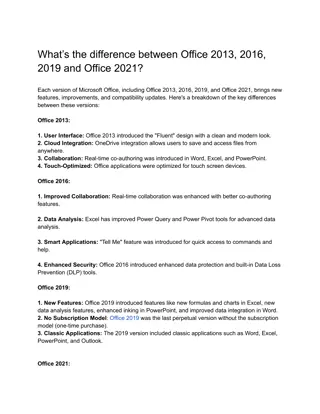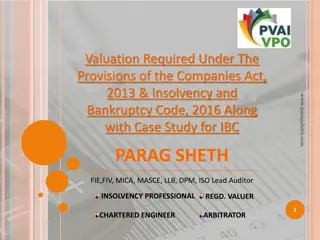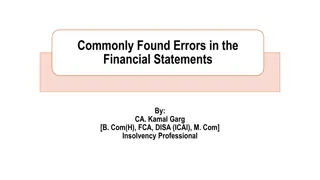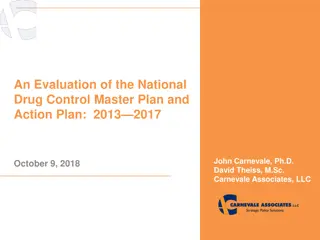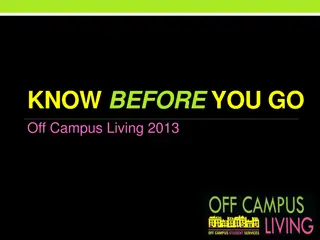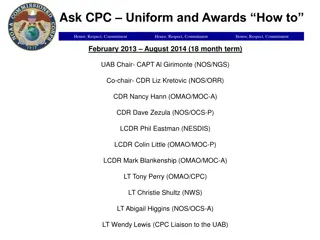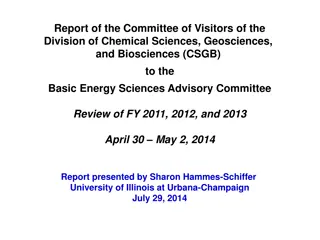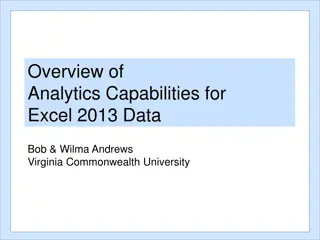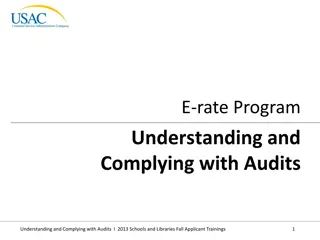
Gaussian Samplers and Iterative Solvers: Implementation Issues and Solutions
Explore the challenges and solutions in implementing iterative Gaussian samplers in finite precision, examining convergence theories, solver errors, and the correspondence between different solvers and samplers. Discover the complexities of samplers in infinite versus finite precision and gain insights into state-of-the-art techniques like CG-Chebyshev-SSOR Gaussian sampler.
Uploaded on | 0 Views
Download Presentation

Please find below an Image/Link to download the presentation.
The content on the website is provided AS IS for your information and personal use only. It may not be sold, licensed, or shared on other websites without obtaining consent from the author. If you encounter any issues during the download, it is possible that the publisher has removed the file from their server.
You are allowed to download the files provided on this website for personal or commercial use, subject to the condition that they are used lawfully. All files are the property of their respective owners.
The content on the website is provided AS IS for your information and personal use only. It may not be sold, licensed, or shared on other websites without obtaining consent from the author.
E N D
Presentation Transcript
Some implementation issues with iterative Gaussian samplers in finite precision Al Parker and Colin Fox SUQ13 January 7, 2013
Outline Iterative linear solvers and Gaussian samplers Convergence theory is the same Same reduction in error per iteration A sampler stopping criterion How many sampler iterations to convergence? Samplers equivalent in infinite precision perform differently in finite precision. State of the art: CG-Chebyshev-SSOR Gaussian sampler In finite precision, convergence to N(0, A-1) implies convergence to N(0,A). The converse is not true. Some future work
The multivariate Gaussian distribution 1 1 = 1 T ( , ) exp ( ) ( ) N y y 2 / 1 2 n 2 det( )
Correspondence between solvers and samplers of N(0, A-1) Solving Ax=b: Gauss-Seidel Chebyshev-GS CG Sampling y ~ N(0,A-1): Gibbs Chebyshev-Gibbs CG-Lanczos sampler
We consider iterative solvers of Ax = b of the form: 1. Split the coefficient matrix A = M - N for M invertible. 2. xk+1 = (1- vk) xk-1 + vk xk + vk uk M-1 (b-A xk) for some parameters vk and uk. 3. Check for convergence: Quit if ||b - A xk+1 || is small. Otherwise, update vk and uk, go to step 2. Need to be able to inexpensively solve M u = r Given M, it s the same cost per iteration regardless of acceleration method used
For example xk+1 = (1- vk) xk-1 + vk xk + vk uk M-1 (b-A xk) Chebyshev-GS CG Gauss-Seidel M = MGSD MTGS, vk and uk are functions of the 2 extreme eigenvalues of I - G=M-1A M = I, vk , uk are functions of the residuals b - Axk MGS = D + L, vk = uk = 1
... and the solver error decreases according to a polynomial, (xk - A-1b) = Pk(I-G)(x0 - A-1b), G=M-1N I G = M-1A CG Gauss-Seidel Chebyshev-GS Pk(I-G) is the kth order Chebyshev polynomial (the polynomial with smallest maximum between the two eigenvalues of I - G). Pk(I-G) = Gk Pk(I-G) is the kth order Lanczos polynomial
... and the solver error decreases according to a polynomial, (xk - A-1b) = Pk(I-G)(x0 - A-1b), G=M-1N I G = M-1A CG Gauss-Seidel Chebyshev-GS Pk(I-G) Pk(I-G) = Gk, Pk(I-G) is the kth order Lanczos polynomial the kth order Chebyshev polynomial, stationary reduction factor is asymptotic average reduction factor is optimal, = converges in a finite number of steps* depending on eig(I-G) p(G) 1 cond ( ) I G + 1 cond ( ) I G
Some common iterative linear solvers convergence guaranteed* if: 0 < w < 2/p(A) Type Splitting: M 1/w I Richardson Jacobi D Stationary (vk = uk = 1) Gauss- Seidel D + L always SOR 1/w D + L 0 < w < 2 w/(2-w) MSORD MTSOR SSOR 0 < w < 2 stationary iteration converges Any symmetric splitting (e.g., SSOR or Richardson) where I-G is PD Chebyshev Non-stationary CG always CG is guaranteed to accelerate * Chebyshev is guaranteed to accelerate*
Your iterative linear solver for some new splitting: convergence guaranteed* if: Type Splitting: M p(G = M-1N) < 1 stationary iteration converges Stationary Your splitting M = ? Non-stationary Any symmetric splitting Chebyshev CG always
For example: convergence guaranteed* if: Type Splitting: M Stationary subdiagonal 1/w D + L - D-1 stationary iteration converges Non-stationary Any symmetric splitting Chebyshev CG always
Iterative linear solver performance in finite precision Table from Fox & P, in prep. Ax = b was solved for SPD 100 x 100 first order locally linear sparse matrix A. Stopping criterion was ||b - A xk+1 ||2 < 10-8.
Iterative linear solver performance in finite precision 1 cond ( ) I G = p(G) + 1 cond ( ) I G
What iterative samplers of N(0, A-1) are available? Solving Ax=b: Gauss-Seidel Chebyshev-GS CG Sampling y ~ N(0,A-1): Gibbs Chebyshev-Gibbs CG-Lanczos sampler
We study iterative samplers of N(0, A-1) of the form: 1. Split the precision matrix A = M - N for M invertible. 2. Sample ck ~ N(0, (2-vk)/vk ( (2 uk)/ uk MT + N) 3. yk+1 = (1- vk) yk-1 + vk yk + vk uk M-1 (ck -A yk). 4. Check for convergence: Quit if the difference between N(0, Var(yk+1)) and N(0, A-1) is small. Otherwise, update linear solver parameters vk and uk, go to step 2. Need to be able to inexpensively solve M u = r Need to be able to easily sample ck Given M, it s the same cost per iteration regardless of acceleration method used
For example yk+1 = (1- vk) yk-1 + vk yk + vk uk M-1 (ck -A yk) ck ~ N(0, (2-vk)/vk ( (2 uk)/ uk MT + N) Gibbs Chebyshev-Gibbs CG-Lanczos MGS = D + L, vk = uk = 1 functions of the 2 extreme eigenvalues of I-G=M-1A M = MGSD MTGS, vk and uk are M = I, vk , uk are functions of the residuals b - Axk
... and the sampler error decreases according to a polynomial, (E(yk) - 0)= Pk(I-G)(E(y0) 0) (A-1 - Var(yk)) = Pk(I-G)(A-1 - Var(y0)) Pk(I-G)T (A-1 - Var(yk))v = 0 for any Krylov vector v CG-Lanczos Gibbs Chebyshev-Gibbs Pk(I-G) = Gk, with error reduction factor Pk(I-G) kth order Chebyshev polyomial, Var(yk) is the kth order CG polynomial optimal asymptotic average reduction factor is converges in a finite number of steps* in a Krylov space depending on eig(I-G) p(G)2 2 1 ( ) cond I G = 2 + 1 ( ) cond I G
My attempt at the historical development of iterative Gaussian samplers: Type Sampler Literature Adler 1981, Goodman & Sokal 1989, Amit & Grenander 1991 Gibbs (Gauss-Seidel) Matrix Splittings Stationary (vk = uk = 1) BF (SOR) Barone & Frigessi 1990 REGS (SSOR) Roberts & Sahu 1997 Generalized Fox & P 2013 Goodman & Sokal 1989 Liu & Sabatti 2000 Multi-Grid Lanczos Krylov subspace Schneider & Wilsky 2003 Krylov sampling with conjugate directions CD Sampler Heat Baths with CG, CG Sampler Fox 2007 Ceriotti, Bussi & Parrinello 2007 P & Fox 2012 Non-stationary Krylov sampling with Lanczos vectors Lanczos sampler Simpson, Turner, & Pettitt 2008 Chebyshev Fox & P 2013
More details for some iterative Gaussian samplers convergence guaranteed* if: 0 < w < 2/p(A) Var(ck) = MT + N 2/w I - A 2D - A Type Splitting: M 1/w I Richardson Jacobi D D GS/Gibbs D + L always Stationary (vk = uk = 1) (2-w)/w D w/(2 - w) (MSORD-1 MTSOR+ NSOR D-1 NTSOR) SOR/BF 1/w D + L 0 < w < 2 w/(2-w) MSORD MTSOR Any symmetric splitting (e.g., SSOR or Richardson) SSOR/REGS 0 < w < 2 stationary iteration converges (2-vk)/vk ( (2 uk)/ uk M + N Non- Chebyshev stationary CG -- always*
Theorem An iterative Gaussian sampler converges (to N(0, A-1)) faster # than the corresponding linear solver as long as vk , uk are independent of the iterates yk(Fox & P 2013). Gibbs Sampler Chebyshev Accelerated Gibbs
Theorem An iterative Gaussian sampler converges (to N(0, A-1)) faster# than the corresponding linear solver as long as vk , uk are independent of the iterates yk(Fox & P 2013). # The sampler variance error reduction factor is the square of the reduction factor for the solver: 2 1 cond ( ) I G Stationary sampler: p(G)2 = 2 Chebyshev : + 1 cond ( ) I G So: The Theorem does not apply to Krylov samplers. Samplers can use the same stopping criteria as solvers. If a solver converges in n iterations, so does the sampler
In theory and finite precision, Chebyshev acceleration is faster than a Gibbs sampler Example: N(0, -1 ) in 100D Covariance matrix convergence, ||A-1 Var(yk)||2 /||A-1 ||2 Benchmark for cost in finite precision is the cost of a Cholesky factorization Benchmark for convergence in finite precision is 105 Cholesky samples
Algorithm for an iterative sampler of N(0, A-1) with a vague stopping criterion: 1. Split A = M - N for M invertible. 2. Sample ck ~ N(0, (2-vk)/vk ( (2 uk)/ uk MT + N) 3. yk+1 = (1- vk) yk-1 + vk yk + vk uk M-1 (ck -A yk). 4. Check for convergence: Quit if the difference between N(0, Var(yk+1)) and N(0, A-1) is small. Otherwise, update linear solver parameters vk and uk, go to step 2.
Algorithm for an iterative sampler of N(0, A-1) with an explicit stopping criterion: 1. Split A = M - N for M invertible. 2. Sample ck ~ N(0, (2-vk)/vk ( (2 uk)/ uk M + N) 3. xk+1 = (1- vk) xk-1 + vk xk + vk uk M-1 (b-Axk) 4. yk+1 = (1- vk) yk-1 + vk yk + vk uk M-1 (ck -Ayk) 5. Check for convergence: Quit if ||b - A xk+1 || is small. Otherwise, update linear solver parameters vk and uk, go to step 2.
An example: a Gibbs sampler of N(0, A-1) with a stopping criterion: 1. Split A = M - N where M = D + L 2. Sample ck ~ N(0, MT + N) 3. xk+1 = xk + M-1 (b - A xk) <------ Gauss-Seidel iteration 4. yk+1 = yk + M-1 (ck -A yk) <------ (bog standard) Gibbs iteration 5. Check for convergence: Quit if ||b - A xk+1 || is small. Otherwise, go to step 2.
Stopping criterion for the CG sampler The CG sampler also uses ||b - A xk+1 || as a stopping criterion, but a small residual merely indicates that the sampler has successfully sampled (i.e., converged ) in a Krylov subspace (this same issue occurs with CG-Lanczos solvers). Only 8 eigenvectors (corresponding to the 8 largest eigenvalues of A-1) are sampled by the CG sampler
Stopping criteria for the CG sampler The CG sampler also uses ||b - A xk+1 || as a stopping criterion, but a small residual merely indicates that the sampler has successfully sampled (i.e., converged ) in a Krylov subspace (this same issue occurs with CG-Lanczos solvers). A coarse assessment of the accuracy of the distribution of the CG sample is to estimate (P & Fox 2012): trace(Var(yk))/trace(A-1 ). The denominator trace(A-1 ) is estimated by the CG sampler using a sweet-as (minimum variance) Lanczos Monte Carlo scheme (Bai, Fahey, & Golub 1996).
Example: 102 Laplacian over a 10x10 2D domain eigenvalues of A-1 37 eigenvectors are sampled (and estimated) by the CG sampler. A=
How many sampler iterations until convergence?
A priori calculation of the number of solver iterations to convergence Since the solver error decreases according to a polynomial, (xk - A-1b) = Pk(I-G)(x0 - A-1b), G=M-1N then the estimated number of iterations k until the error reduction ||xk - A-1b|| / ||x0 - A-1b < is about (Axelsson 1996): Stationary splitting: k = ln / ln(p(G)) Chebyshev: k = ln( /2)/ln Gauss-Seidel Chebyshev-GS Pk(I-G) is the kth order Chebyshev polynomial Pk(I-G) = Gk 1 cond ( ) I G = + 1 cond ( ) I G
A priori calculation of the number of sampler iterations to convergence ... and since the sampler error decreases according to the same polynomial (E(yk) 0)= Pk(I-G)(E(y0) 0) (A-1 - Var(yk)) = Pk(I-G)(A-1 - Var(y0)) Pk(I-G)T Gibbs Chebyshev-Gibbs Pk(I-G) Pk(I-G) = Gk is the kth order Chebyshev polynomial
A priori calculation of the number of sampler iterations to convergence ... and since the sampler error decreases according to the same polynomial (E(yk) 0)= Pk(I-G)(E(y0) 0) (A-1 - Var(yk)) = Pk(I-G)(A-1 - Var(y0)) Pk(I-G)T THEN (Fox & Parker 2013) the suggested number of iterations k until the error reduction ||Var(yk ) - A-1|| / ||Var(y0 ) - A-1|| < is about: Stationary splitting: k = ln / ln(p(G)2) 2 1 ( ) cond I G Chebyshev: k = ln( /2)/ln( 2), = 2 + 1 ( ) cond I G
A priori calculation of the number of sampler iterations to convergence For example: Sampling from N(0, -1) Predicted vs. Actual number of iterations k until the error reduction in variance is less than = 10-8: Predicted 14161 Actual 13441 SSOR Solvers Chebyshev- SSOR SSOR Chebyshev- SSOR 269 7076 296 -- Samplers 135 60* p(G) = 0.9987, = 0.9312, Finite precision benchmark is the Cholesky relative error = 0.0525
Equivalent sampler implementations yield different results in finite precision
Different Lanczos sampling results due to different finite precision implementations It is well known that equivalent CG and Lanczos algorithms (in exact arithmetic) perform very differently in finite precision. Iterative Krylov samplers (i.e., with Lanczos-CD, CD, CG, or Lanczos-vectors) are equivalent in exact arithmetic, but implementations in finite precision can yield different results. This is currently under numerical investigation.
Different Chebyshev sampling results due to different finite precision implementations There are at least three implementations of modern (i.e., second-order) Chebyshev accelerated linear solvers (e.g., Axelsson 1991, Saad 2003, and Golub & Van Loan 1996). Some preliminary results comparing Axelsson and Saad implementations:
A fast iterative sampler (i.e., PCG-Chebyshev-SSOR) of N(0, A-1) (given a precision matrix A)
A fast iterative sampler for LARGE N(0, A-1): Use a combination of samplers: Use a PCG sampler (with splitting/preconditioner MSSOR) to generate a sample ykPCG approx. dist. as N(0, MSSOR1/2 A-1 MSSOR1/2 ) and estimates of the extreme eigenvalues of I G = MSSOR-1A. Seed the samples MSSOR-1/2 ykPCG and the extreme eigenvalues into a Chebyshev accelerated SSOR sampler. A similar to approach has been used running Chebyshev-accelerated solvers with multiple RHSs (Golub, Ruiz & Touhami 2007).
Example sampling via Chebyshev-SSOR sampling from N(0, -1 ) in 100D Covariance matrix convergence, ||A-1 Var(yk)||2 /||A-1 ||2
Comparing CG-Chebyshev-SSOR to Chebyshev-SSOR sampling from N(0, ): ||A-1 Var(y100)||2/||A-1 ||2 0.992 0.973 0.805 0.316 0.757 0.317 w 1 Gibbs (GS) SSOR 0.2122 1 0.2122 1 0.2122 Chebyshev-SSOR CG-Chebyshev- SSOR Cholesky -- 0.199 Numerical examples suggest that seeding Chebyshev with a CG sample AND CG-estimated eigenvalues do at least as good a job as when using a direct eigen-solver (such as the QR-algorithm implemented via MATLAB s eig( )).
Convergence to N(0, A-1) implies convergence to N(0,A). The converse is not necessarily true.
Can N(0, A-1) be used to sample from N(0,A)? If you have an exact sample y ~ N(0, A-1), then simply multiplying by A yields a sample b = Ay ~ y ~ N(0, AA-1A) = N(0, A). This result holds as long as you know how to multiply by A. Theoretical support: For a sample yk produced by the non-Krylov iterative samplers presented, the error in covariance of Ayk is: A - Var(Ayk) = APk(I-G)(A- Var(Ay0)) Pk(I-G)T A = Pk(I-GT)(A- Var(Ay0)) Pk(I-GT) T Therefore, the asymptotic reduction factors of the stationary and Chebyshev samples of either yk or Ayk are the same (i.e., p(G)2 and resp.). ) ( 1 G I cond 2 1 ( ) cond I G = 2 + Unfortunately, whereas the reduction factor 2 for Chebyshev sampling yk ~ N(0, A-1) is optimal, 2 is (likely) less than optimal for Ayk ~ N(0, A).
Example of convergence using samples yk~N(0, A-1) to generate samples Ayk ~ N(0, A) A =
How about using N(0,A) to sample from N(0,A-1)? You may have an exact sample b ~ N(0, A) and yet you want y ~ N(0, A-1) (e.g., when studying spatiotemporal patterns in tropical surface winds in Wikle et al. 2001). Given b ~ N(0, A), then simply multiplying by A-1 yields a sample y = A-1b ~ N(0, A-1AA-1) = N(0, A-1). This result holds as long as you know how to multiply by A-1. Unfortunately, it is often the case that multiplication by A-1 can only be performed approximately (e.g., using CG (Wikle et al. 2001)). When using the CG solver to generate a sample ykCG ~= A-1 b when b ~ N(0,A), ykCG approx. A-1 b gets ``stuck in a k-dimensional Krylov subspace and only has the correct N(0, A-1) distribution if the k-dimensional Krylov space well approximates the eigenspaces corresponding to the large eigenvalues of of A-1 (P & Fox 2012). Point: For large problems where direct methods are not available, use a Chebyshev accelerated solver to solve Ay = b to generate y ~ N(0, A-1) from b ~ N(0,A)!
Some Future Work Meld a Krylov sampler (fast but stuck in a Krylov space in finite precision) with Chebyshev acceleration (slower but with guaranteed convergence). Prove convergence of the Chebyshev accelerated sampler under positivity constraints. Apply some of these ideas to confocal microscope image analysis and nuclear magnetic resonance experimental design biofilm problems.

